Chokecherries: Beauty, Food, Medicine, Wine, Natural Dyes, Tree Propagation and More!
The Chokecherries are ripening! Their bright red berries have been calling out to us the last few weeks. The Chokecherries are best harvested when the fruits darken towards late August into September depending on your climate. But we couldn't wait to harvest some and enjoy our local Chokecherries!
This is our third year working with Chokecherries and we are appreciating this wild tree more and more! Let us share with you some interesting ways that you can enjoy the Chokecherry tree!
But if nothing else - we invite you to take a minute to stop and enjoy the Chokecherry tree's beauty and appreciate the abundance of food that it offers the wildlife and some adventurous hippies.
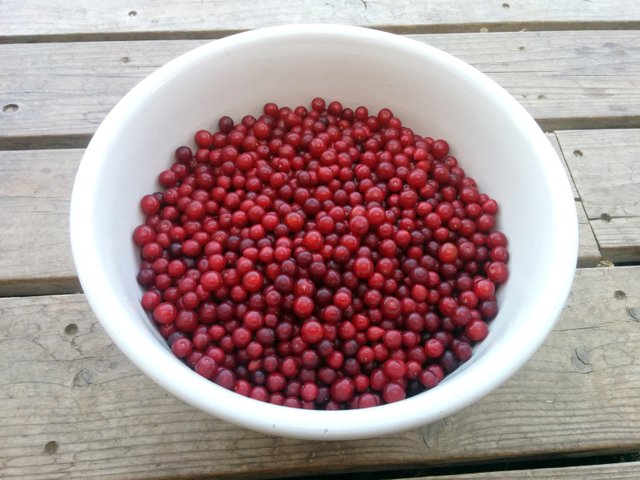
Prunus Virginiana
Chokecherry, Western Chokecherry, Black Chokecherry
The Chokecherry is a shrub/small tree growing 8-15 feet tall belonging to the Rosaceae family and can be found widely across the Northern portion of North America
The Chokecherry trees, somewhat ambiguous after the flowers faded, once again began calling out in vibrancy, early-to-mid August here, with their shiny bright red berries from road sides and creek sides.
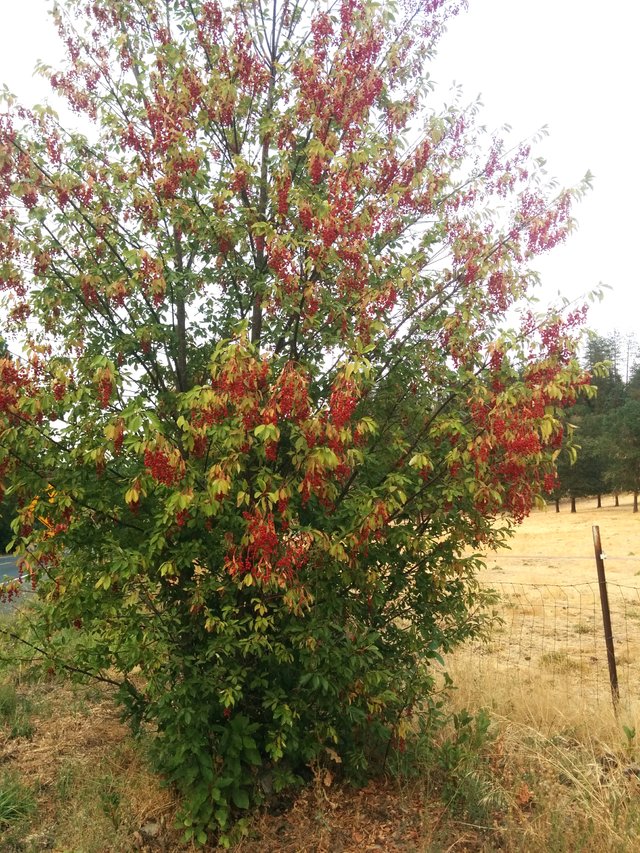
Chokecherry leaves are simple, alternate and are 1.5-2.5 inches long with serrated edges. The fruits are about 1/4 inch and hang in clusters. The berries contain a large pit, similar to cultivated cherries.
I recommend The Forager's Harvest by Samuel Thayer for more detailed identification notes. Once you become familiar with the tree, it is easy to identify when it is fruiting and flowering.
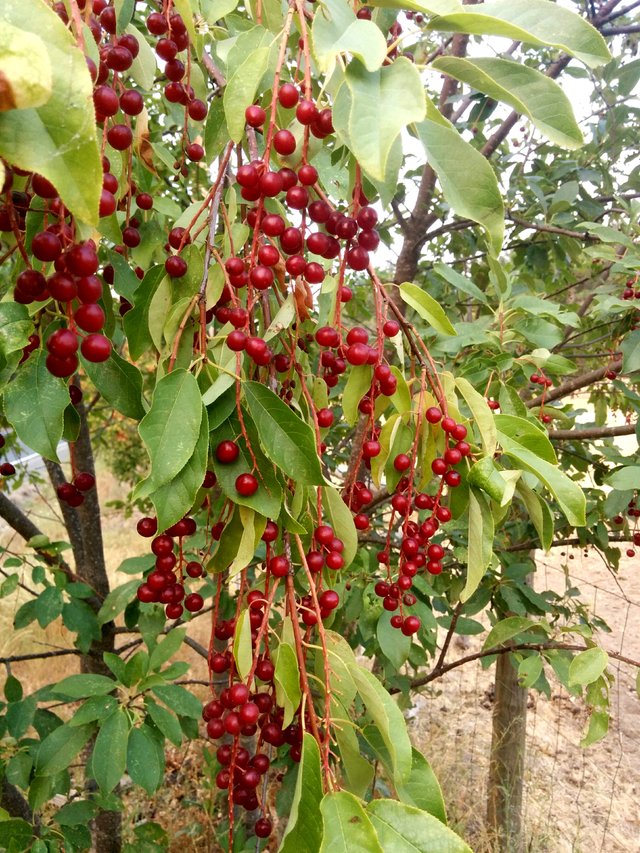
The Chokecherry is aptly named as the ripe berry is tart and has a somewhat dry aftertaste which might leave you smacking your tongue against the roof of your mouth!
Nonetheless the fruit is sweet and delicious, even if you can only manage to eat a few at a time. Myself, I have acquired a taste for them and enjoy eating them in larger quantities fresh.
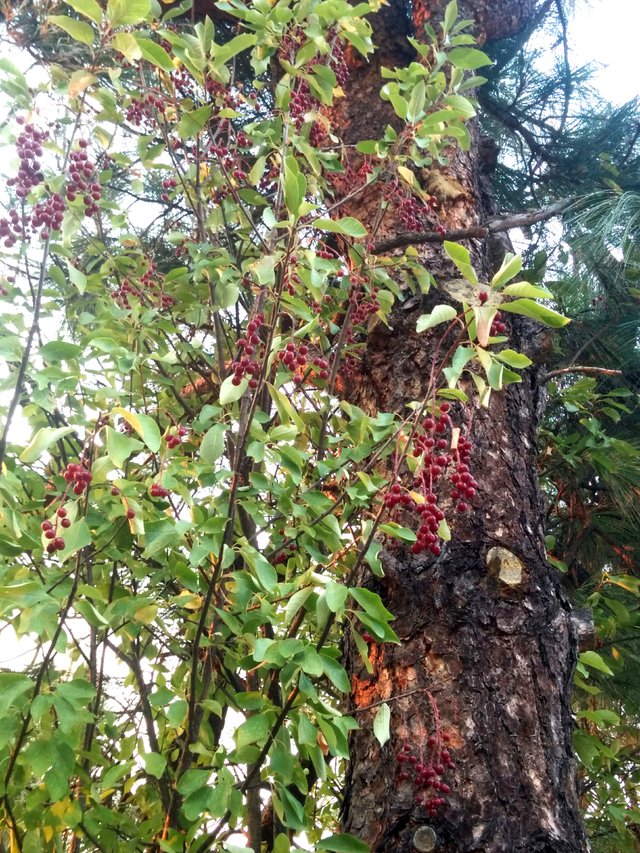
But if you've read this far and aren't 100% repulsed yet let me assure you that there are many ways to enjoy this prolific, abundant, wild fruit!
- Waiting until the fruit is over ripened and dark or black in color, the fruit becomes much more palatable.
- Chokecherries lend themselves very well to wine and cordials for those that are alcoholically inclined
- Chokecherries make a delicious syrup for those that aren't
- Drying the cherries removes the dry or "choke" part of the flavor and leaves the sweetness without needing added sugar!
- Chokecherries make delicious jelly!
- The bark of the tree is good cough medicine
- The fruit pulp can be used as a natural dye
We have worked with the Chokecherry in many (but not all) of the ways and will elaborate on some of them below. Read on!
Chokecherry Medicine
Chokecherry bark is a very effective cough medicine. According to Michael Moore, it is especially helpful for children with cardiopulmonary excitability.
If your child is lying in bed, glowing a dull infrared and breathing rapidly with a dry cough, give him/her Chokecherry.
...
The mechanism might make a pharmacologist cringe because it so closely resembles that of a true cyanotic poisons, but once again, it is safe and reliable for even small children. It has been used safely for centuries, probably millennia, in such diverse places as Siberia, Germany, the lakeside villages of the Mandan, the mountains of northern New Mexico, and the valleys of Kentucky.Medicinal Plants of the Mountain West by Michael Moore
Chokecherry inner bark has also been used to treat diarrhea, sore throats, worms, headaches and heart conditions.
Chokecherry bark can be prepared as an Infusion or Tincture. It can be collected anytime but ideally in the fall or early spring, taking care not to collect too much from any one place on the tree and not to girdle the tree. Pruned branches can be used so as to not tap the bark of the main trunk.
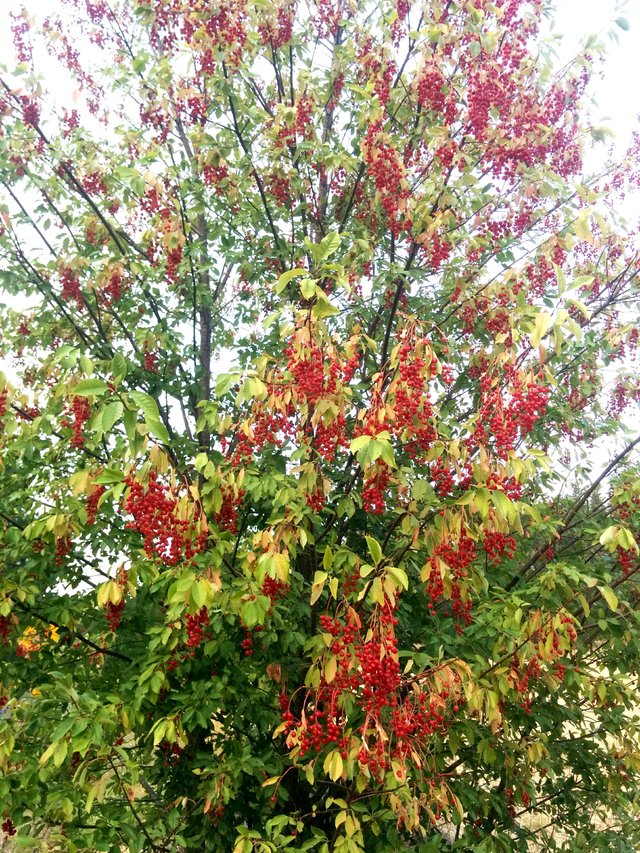
Chokecherries as Food
Chokecherries make a nice snack out of hand, especially when over ripened. I will plan to report back later this season when the Chokecherries turn dark and sweeter!
I couldn't help but snack on them as I harvested, spitting out the hard pits and smacking my lips to the dry flavor left in my mouth. Dryness aside, the flavor is quite sweet, juicy and delicious.
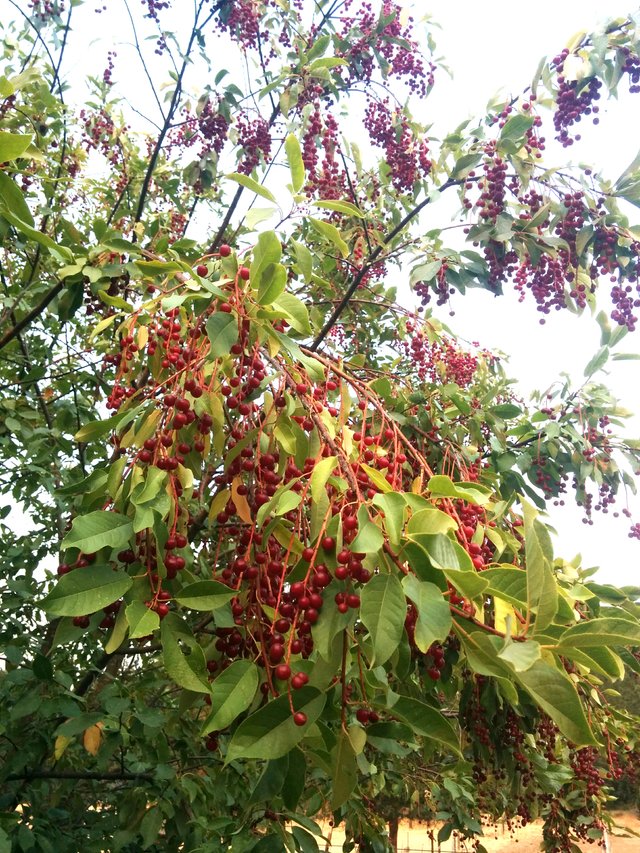
The harvest is so fun! Chokecherries tend to produce so abundantly. Somewhat akin to harvesting currants, Chokecherries hang in clusters of many berries. You can grab a cluster and put it in your harvest bucket or you can enclose your hand around a cluster of berries and just strip them off all in one pass.
The berries hold up well to being stripped off. I would recommend this method for efficiency especially if you will be processing or eating your Chokecherries within a few days.
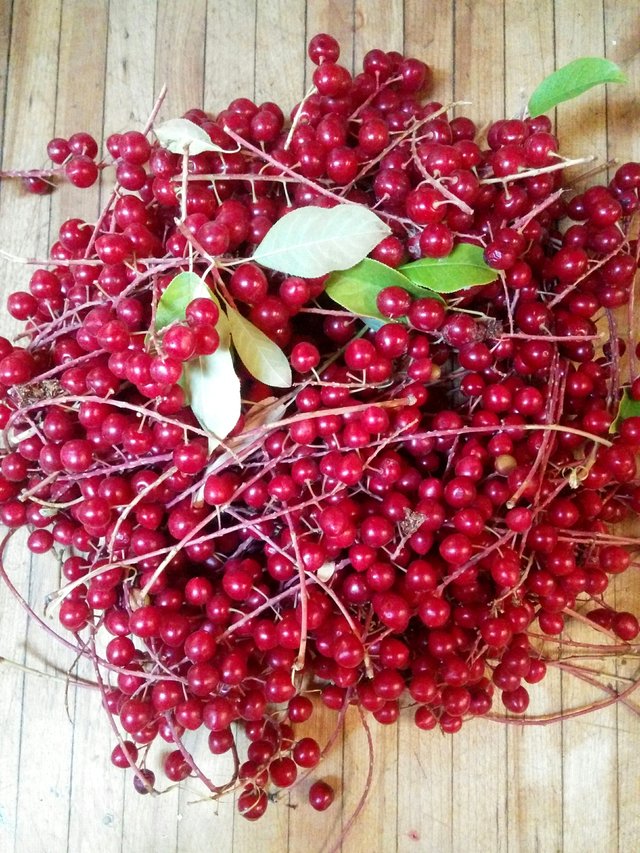
If you may not get to your Chokecherries for a while and want them to last longer at room temperature clipping them off as a bunch and keeping them intact on the stem would make the most sense, since you aren't opening the berry up by pulling it off the stem.
In either case the Chokecherries are easy to harvest, relatively sturdy and resistant to bruising - so you don't have to be overly careful when dropping them in your bucket.

Fruit Leather - Preserving the Harvest
I have dried the berries whole and they taste great but its not ideal to eat dried berries with the pit intact. This time I decided to make fruit leather and separate the pits from the juice.
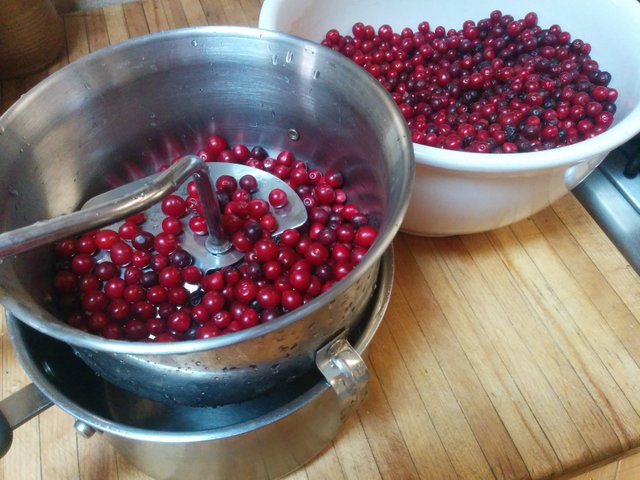
I began by using a hand crank food mill to try to separate the pits from the juice.
Learn from my mistake! Don't do this! At least with my food mill half the pits were cracked, the other half were not and it was a very inefficient method to get a tiny bit of juice out. I think this food mill is better suited to smaller seeds, skins and pulp than it is for large pits.
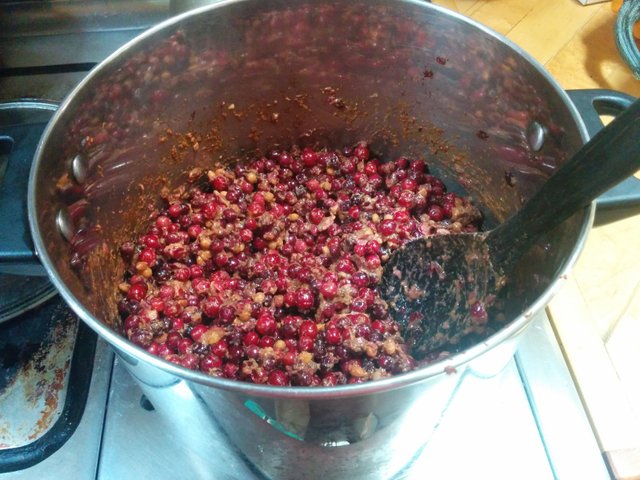
I moved on to using a different kind of food mill with a pestle type of tool (that my mom found for me at a swap meet!) I also ended up cooking the Chokecherries for a short while soften them up.
As I cooked them this made me think that with the tartness and flavor of the Chokecherry they would make a great sustainable and local alternative to Cranberries for a holiday sauce!
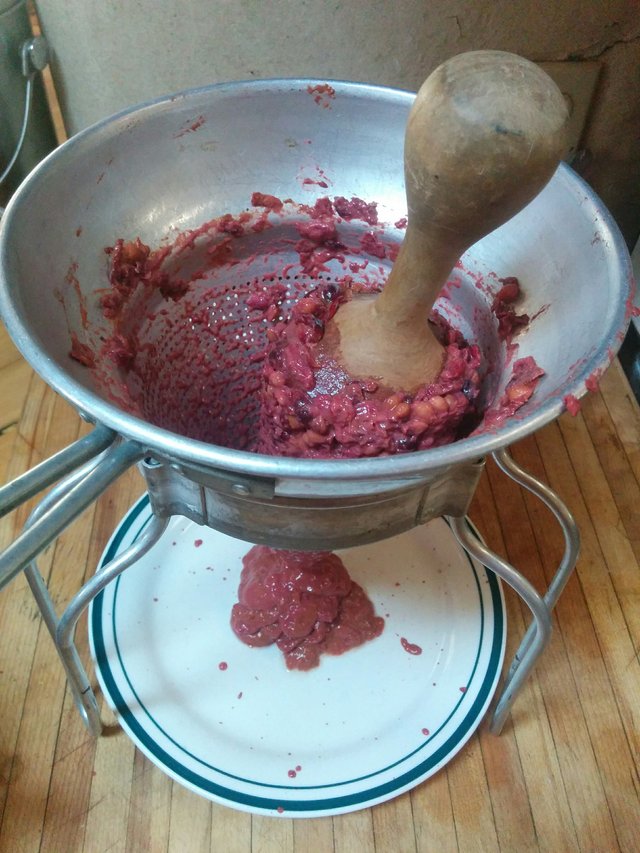
This tool turns out to be much better suited for the job.
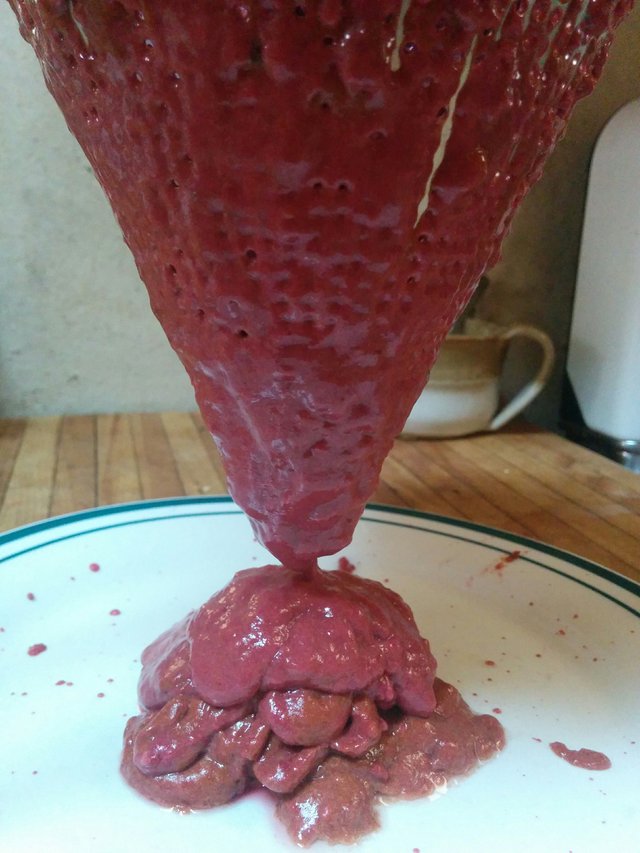
I processed the Chokecherries in batches and after several rounds of grinding on the pits and pulp I got a decent amount of juice out.
Juice is not the right word though. This stuff is thick! It's more of a sauce! Let me tell you the Chokecherry juice gels up so well and so fast that it would lend itself VERY well to a jelly. There is so much pectin in this fruit.
So with this harvest I ended up with two plates of Chokecherry leather
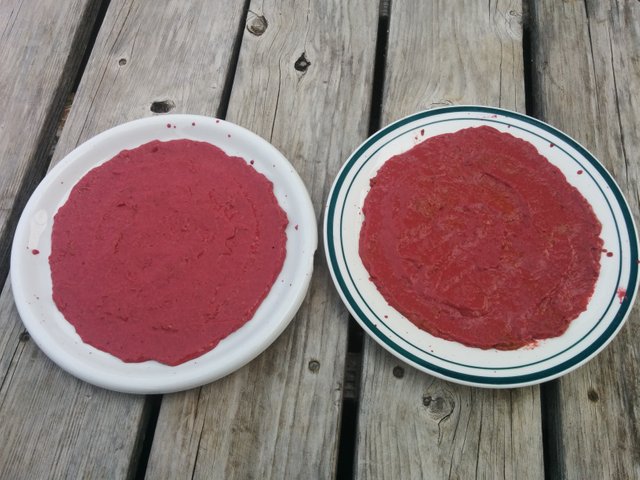
As you can see, this stuff is quite thick. It's going to make a great leather.
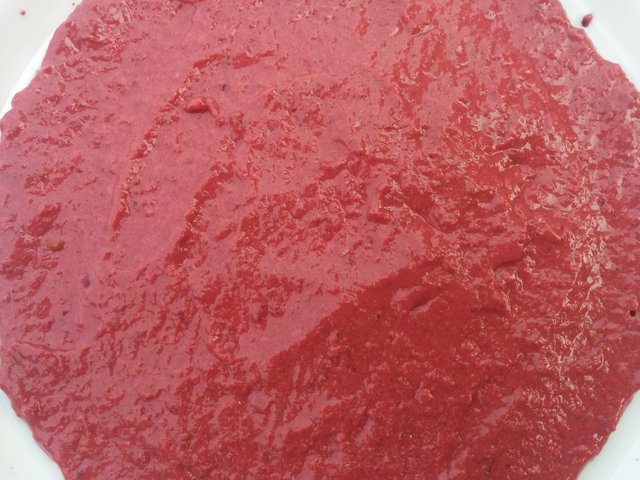
They get popped in the solar dehydrator for a few days but you could also just leave it in the sun on a hot day.
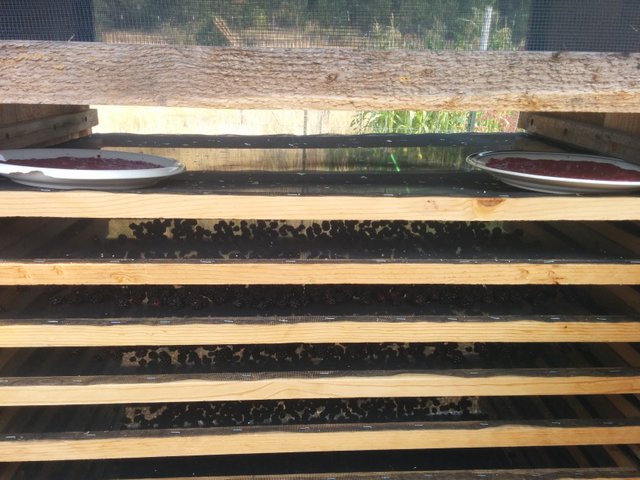
The next day I check on them and they appear dry but after peeling up the sides I notice the middle is still a bit moist sticking to the plate, so I pop them back in for another day in the sun.
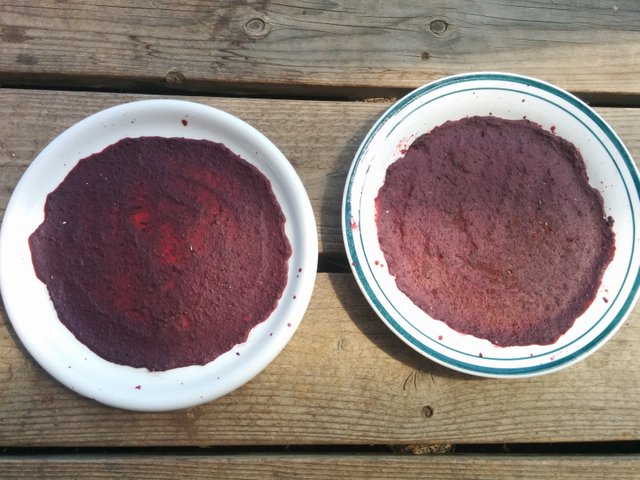
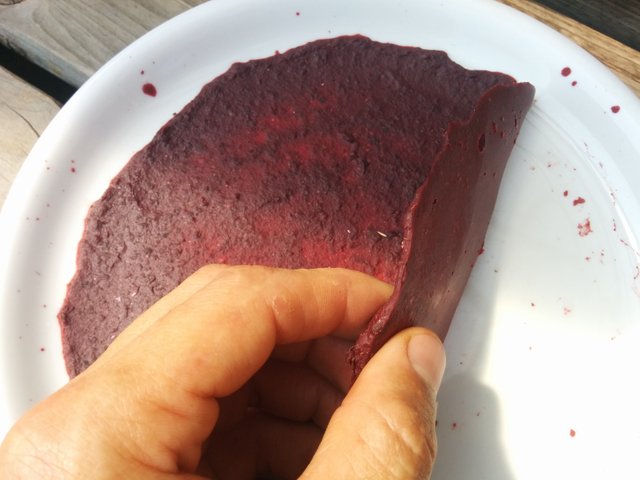
Finally the Chokecherry leather is dry! And I sample a piece--- delicious! It is sweet and has a complex flavor, and none of the "choke" part that I mentioned earlier.
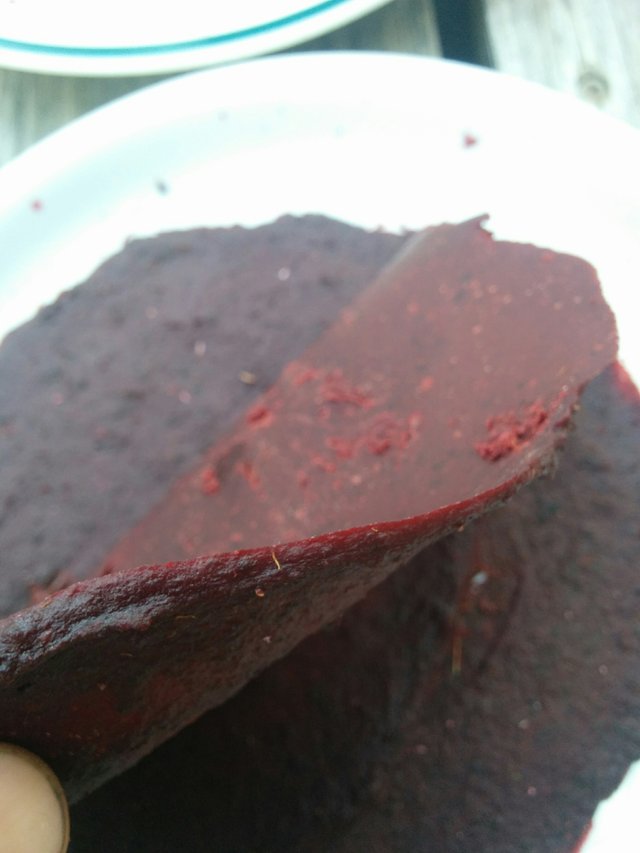
These delicious wild fruit strips will be savored :)
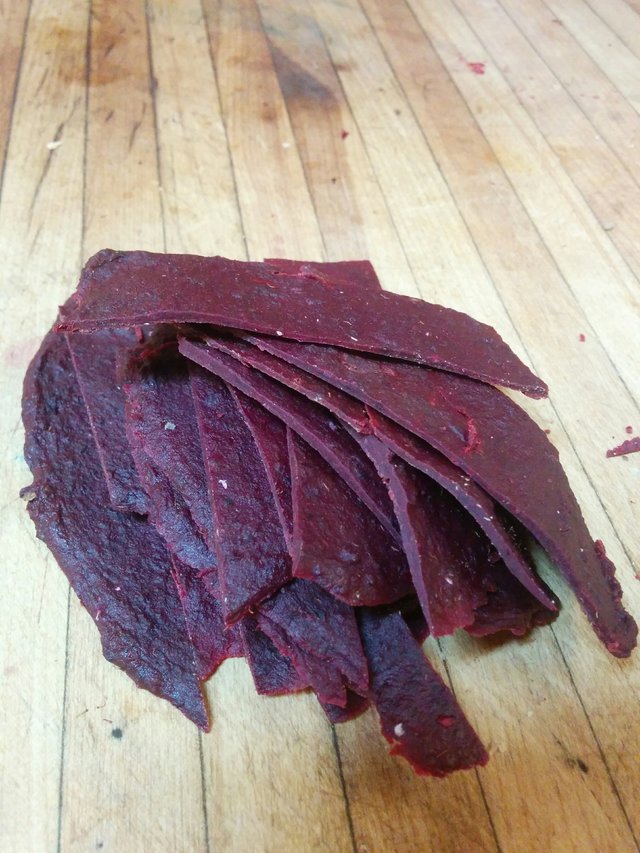
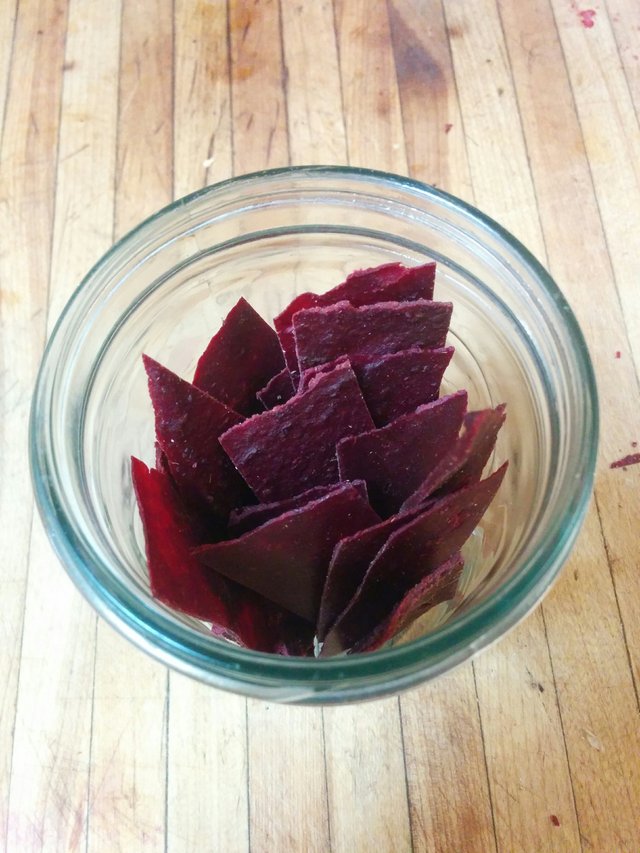
A note on the processing:
This was quite a bit of labor processing the Chokecherries. It was a labor of love. And I don't mind it because I learned a lot, am embracing a local wild food source and in addition Idyllwild will be using the pits and pulp that didn't make it into the leather.
However while the fruit leather was drying I hopped online and did some research on how other people process their Chokecherries. I learned that native Americans would grind the chokecherries pits and all before drying. The pits are nutritious and medicinal and and accessible food once ground and dried. I look forward to trying this later this year, possibly once I have my grain mill set up which would easily grind the pits.
Propagating Chokecherries by Seed
An added bonus of this harvest is that these Chokecherry pits can potentially become future trees! I like the idea of planting Chokecherries in the future so that there can be more wild food for the birds, critters and humans of the future.
Propagating is simple. I first mash a few berries and ferment them in a small amount of water for a few days. After a day or two I rinse out the pulp and rub them over a screen and soak them for another day or two. Repeat this two or three times until the seeds are clean. This photo is after the first rinse.
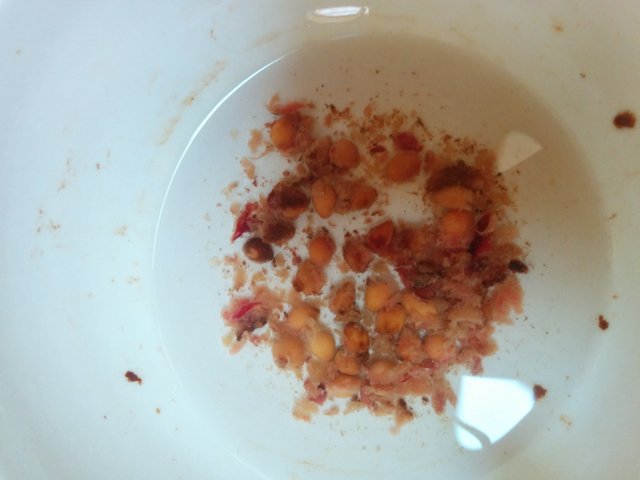
Then the seeds can be placed in a pot with some soil and left out to stratify through the cold winter and hopefully sprout the next/spring summer.
Or they can be dried and stratified later with lower germination rate but more portability.
Chokecherry Cordial
2 years ago I made a Chokecherry cordial and opened it to drink with my friends at Christmas. Let me tell you -- it was DELICIOUS!
This was my first Chokecherry preparation and good thing I didn't know about Chokecherry's medicinal qualities at that point because we probably would have drank it all anyway.
Here is the recipe -
- Fill a jar with chokecherries
- Fill it again with sugar (you might need to do some shaking
- Fill it again with vodka
- Put a lid on it and wait at least one month
That's it! It was so good. This would be an easy way to make chokecherry syrup if you didn't want to make the effort of cooking it.
Chokecherry Wine
Last year I made wine with Chokecherries. This was also delicious as I tasted it at the time of racking and bottling. It hasn't reached it's potential yet because it is aging in the bottle. But I really enjoyed the flavor at the time of bottling and I know it is going to age well and produce a delicious wine!
When I finished the primary fermentation I took the fruit pulp and pits and fed them out to my friend's chickens :) You could also chuck them into the compost or try to sprout the pits!
Natural Dying with Chokecherries
After sagescrub made wine and fruit leather from the chokecherries we harvested a long the road, I asked him to save the pulp, pits, and stems for me.
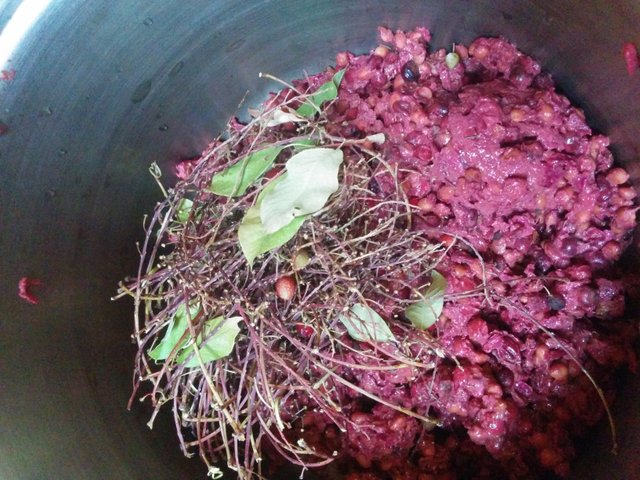
This might look like compost to some, but to me this is a potential pot of natural pigment! Whenever we harvest anything, one of my first question is always "Can that be used as a dye?" Inevitably this curiosity would lead me to dig deeper and discover how indigenous people of the U.S. have used a large variety of local plants for multiple purposes from medicine to bows to dye.
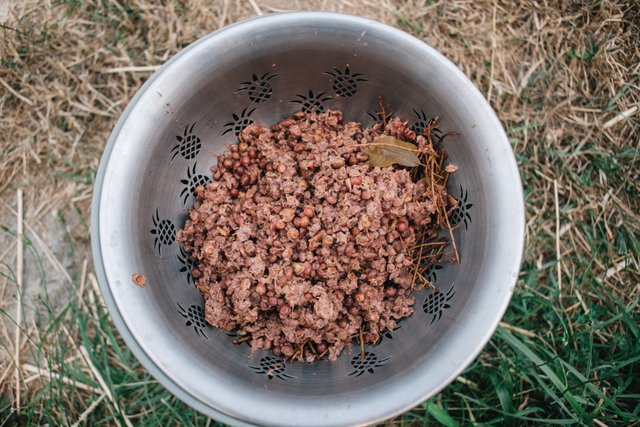
My search about chokecherries yielded the following anecdote from the USDA's website: "Like many plants and animals which were vital to their survival some tribes used parts of the chokecherry plant in their rituals. A green dye was derived from the leaves, inner bark and immature fruit. A purplish-red dye was derived from the ripe fruit. The Cheyenne used the limbs to make arrow shafts and bows. The Crows used it for tipi stakes and pins. Mountain men washed their steel traps in water boiled with the bark to remove the scent. It is speculated many tribes planted seeds in places they frequented to ensure a supply of chokecherries was always available."(https://plants.usda.gov/plantguide/pdf/cs_prvi.pdf)
Also, my hunch is that the "choke" part of the cherry is caused by tannins, which I've learned is the key to holding colors. Dyes made from plants with a natural source of tannin such as most oaks and walnuts are very long lasting and do not require use of mordants (often made from metallic salts like aluminum sulfate) to hold the color.
So, let's see what color chokecherry will make!
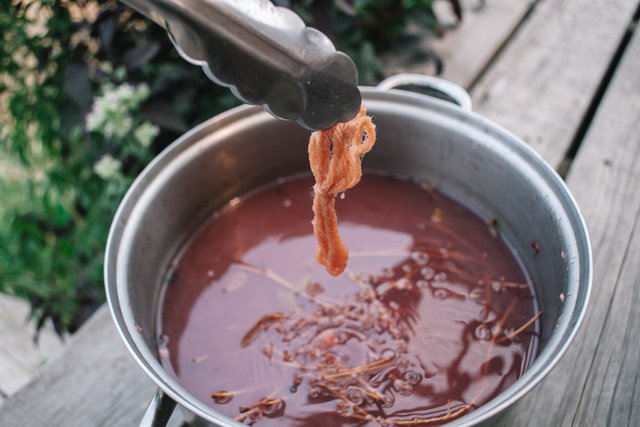
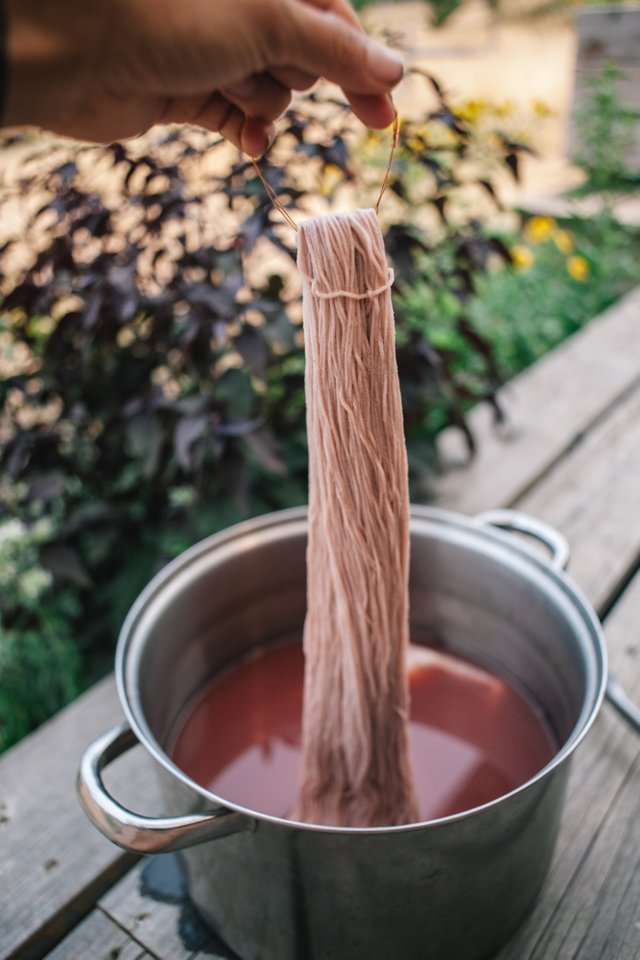
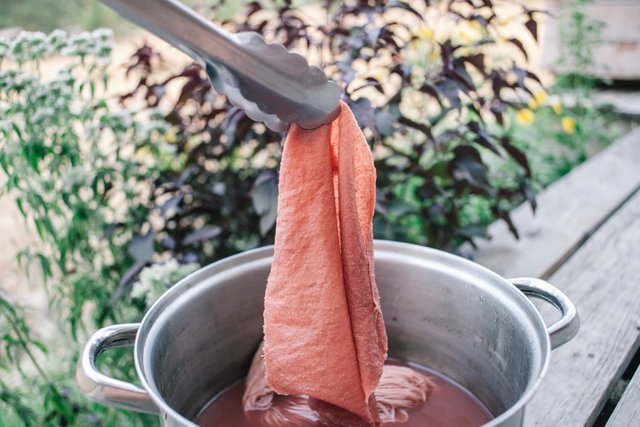
I tested the dye with three different fibers: wool (the small strand), cotton (the yarn skein), and raw silk (the square).
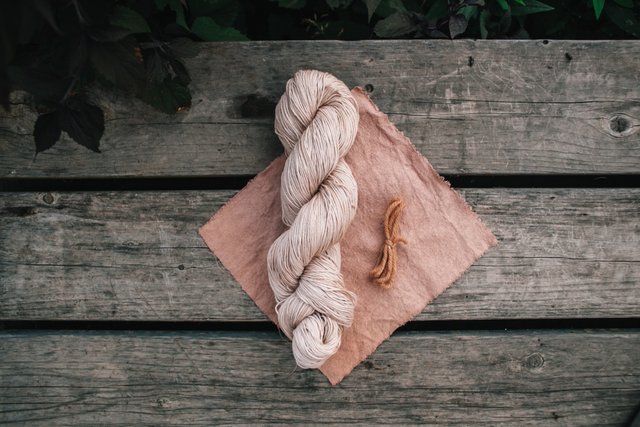
Protein fibers (silk, wool, angora, alpaca) take on colors much more deeply than cellulose fibers (cotton, hemp, bamboo), so that's why the cotton yarn looks much lighter.
I probably didn't get the "purplish-red" color mentioned because I used the left over parts of post-processed chokecherries. Secondly, we harvested from a tree that had light red fruits rather than darker red fruits. All in all, I love the color and it feels good being able to make the most of our chokecherry harvest!
Range
Quick update: Several commenters wondered if Chokecherry grows where they live. I discovered that Chokecherry has quite a LARGE range in North America. It has adapted to different climates nicely!
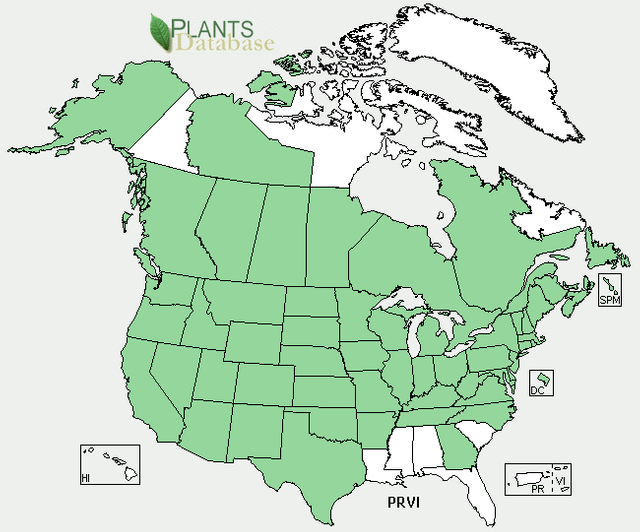
NRCS Plants Database - Prunus virginiana
Proudly Contributing To:

#naturalmedicine | Introducing @naturalmedicine | Discord Community
I really enjoyed this post!
My mother used to take us picking all kinds of fruit and berries in the summer when we were kids, including chokecherries and pin cherries. She always made jelly with them. She kept picking things like chokecherries long after I left home and making jelly from them.
I didn't know that the pits were edible when ground up.
Wow that is so cool! you have an awesome mom! Sounds like nice memories :)
That's a lot of usefulness from one little tree! Wonder if they'll grow in Texas...
I was wondering the same thing.
Yes I think they will. I just read that they have adapted quite widely with an example of some chokecherries growing in Arizona amongst sage brush. It might be helpful to propagate from plants are are growing in similar climate already.
Wonderful in-depth and informative post @sagescrub! Nice accomplishment guys. Chokecherries were part of our pantry growing up. Grandpa would pick them and grandma would make her famous home milled flour pancakes to enjoy the syrup on. It's so tasty! And, such a rich deep purple color. Yum!! I love that you've used them also as a dye. That fruit leather looks wonderful. It's nice you found the proper tool to press out the fruit and separate the pits. Though if the pits are that nutritious would be great to process them enough to add back in to the final product. Awesome homesteading guys ❤
How wonderful! I am just discovering them these last few years. How amazing that your family has been enjoying wild food and passing that joy down to you. Home milled flour pancakes... i am jealous of your childhood memories!! That sounds good. I am going to plan on doing that this winter with my cornmeal :)
Wow! That's a fascinating article... I never knew about leathers, and didn't know where you were going to go with it - the end product, I would definitely like! And I love that the tree is so pretty with the berries in the first place, without even going into all the uses! A jam/jelly would be good I'm sure! Pity we don't have it here.... Oh well, it was fun reading about your harvest.... :) Cheers!!
No worries @ackhoo.. you can make leathers with many fruits! Some may lend themselves better than others. Thanks for your nice comment :)
Great article! here's mine on related species :)
https://steemit.com/nature/@artofwisdom/world-wild-flora-prunus-padus-bird-or-hag-cherry-or-berry-i-ll-take-that
What a coincidence! They look so familiar but different. It sounds delicious and fun!
Die,fruit strip,wine,fruit chokecherries are super useful.Very intersting @sagescrub
Mind. Blown. This is fantastic!!! Such rich knowledge. I havent heard of them really... Ive never seen them in Australia amd I cant recall seeing them in the Uk either. That fruit leather looks amazing. Resteeming!
Thank you @riverflows :) It is native to north america but I just read that chokecherry is quite varied and adaptable to different climates including desert of Arizona. It may just grow where you live - possibly depending on the seed source!
Im quite tempted to have a go!!!
Woo! Love your post - we've given you a 100 percent upvote resteemed it... hope this helps you continue to write such amazing posts. We thank you for using the #naturalmedicine tag so we can more easily find you.
If you're a supporter of all things natural healing, and haven't already got on board our collective, you might like to read our introductory post here. We'd also love to welcome you on Discord here!! Delegations appreciated in order to support our growing collective - to do so click here.
Thank you so much @naturalmedicine! inspired to write more :)
I love choke cherries!
I was introduced to this wonderful food when I was in South Dakota 16 years ago. Chokecherry jam! Mmmmmmm ...... 🤤
I’d love to hear more about the wine, that would be an interesting flavour. I wonder what it would be like in beer? What’s their sugar level like?
Great article!
Yes you can make beer with it or include it in beer. When I make beer it's typically more of a wine because i dont use grains, just fruit and sugar. You could omit the sugar if you don't care about long shelf life or higher alcohol content. Apparently sugar content can be up to 14%.
i like Chokecherries..
Awesome photographs friend..
You work very hard for this article.
Amazing article my dear friend..